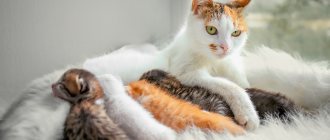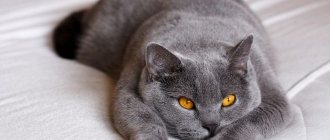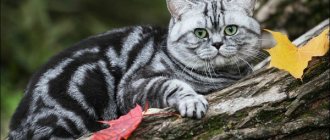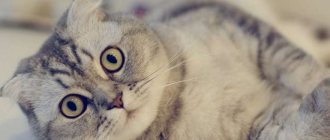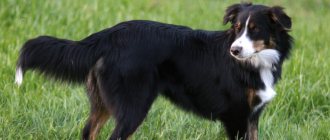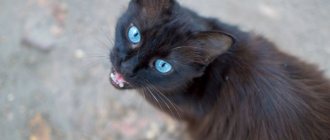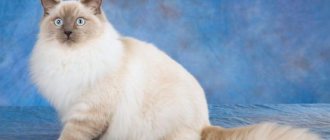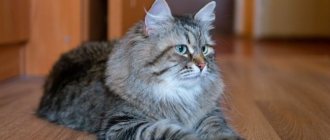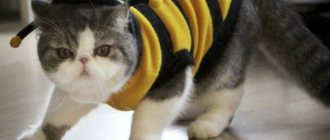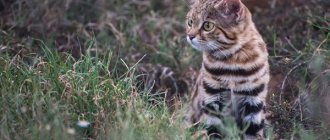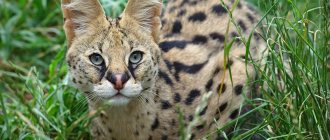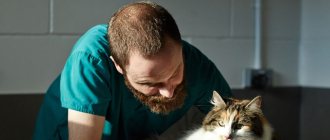History of the origin of the British Shorthair cat breed
The history of the British Shorthair began many centuries ago. It’s nice to think that the country of origin of the British is Great Britain. However, the ancestors of the British were popular back in Roman times. Back then, pets were valued for their hunting instinct. They saved crops and protected houses from small rodents. Back then they were distinguished by their elegance and thin legs.
The breed in its modern sense originated in the 19th century. Then wild relatives significantly improved the gene pool of the British. Until the 19th century, the British cat was formed under the guidance of nature itself. As a result, after several centuries we have a pretty, well-proportioned animal. If their development history were brief, then their appearance would be simpler.
From Great Britain the pet began to be transported to different parts of the world, and so the cat spread throughout the world.
Interesting!
It is believed that it was the Romans who brought cats to the British Isles. According to another version, the British came to Europe during the Crusades, and came to England with French sailors.
The first official cat show took place in 1871. It was organized by a man named Harrison Ware. The next thing he did was develop a rating system, convene the participants and agree on the venue. The morning after the exhibition, the newspapers were full of photographs of British aristocratic cats. This is how British cats gained their first popularity. A little later, a generally accepted breed standard and the first official kennels appeared.
Interesting!
The breed is rarely found in the United States, but in the UK it occupies a leading position in popularity.
After the Second World War, most of the purebred British disappeared. To restore the population, cats began to be crossed with Russian Blue cats and Persians. For a long time, official phenological organizations did not want to recognize the new breed due to mixed blood. However, in 1970 they were recognized by the ACFA, and in 1980 by the CFA. In the same 1980, British dogs were brought to Moscow.
What breeds were involved in the creation of British cats
British cats are considered by some to be an aboriginal breed - one that formed on its own, without active human intervention. In many ways this is true. Cats were brought to the islands of Great Britain by Roman legionnaires many years ago. On an island isolated from the mainland, the cat population developed “in itself”, without the infusion of fresh blood, but with strict natural selection. After all, cats did not live in houses, but on farms, fields, grain barns and factories. As a result, large cats with heavy bones and dense, thick short hair roamed the streets of England.
British cream color
At the end of the 19th century, targeted selection of British cats began, and for some time the breed was called the “British Blue”. At first, blue was the only acceptable color, then it was the most common, but now the variety of colors of the British is amazing.
"Classic" blue color of British cats
The breed's numbers declined twice in the 20th century - after the First and Second World Wars. In order not to lose the British, they were crossed with ordinary outbred shorthair cats. And in order to return the desired rounded appearance of the head, they began to involve in the breeding of Persians.
It was not possible to obtain stable offspring, and the British began to be mated with Russian blue cats, as well as Chartreux cats. Then they returned to the infusion of Persian blood, weeding out kittens that were too snub-nosed or had long hair. It was the Persians who “gave” British cats more than 200 variations of coat color.
In 1982, the two breeds were finally separated: British and European Shorthair. At the same time, the British breed standard was written.
Appearance of the British Shorthair cat
The British shorthair cat has a description that cannot be compared with artificially bred breeds. Nature itself worked on her, so she is perfect from the top of her head to the tip of her tail.
The breed standard helps determine the pedigree of an animal. A brief description can be presented as follows - a large head, chubby cheeks and thick paws.
Height and weight
Medium sized cats. Females weigh 5-6 kg. Males gain weight up to 7-9 kg. The pet gains its final weight by the age of 3-4 years. Representatives of this breed are prone to gaining excess weight. Height at the withers is 28-33 cm.
Length and shape of limbs
The paws are massive and short. The fingers are plump and close tightly. The pads are soft. The tail is thick. The tail is of medium length and has a rounded tip.
Head
The head is round. The main feature is voluminous cheeks. The forehead is rounded. The transition from the forehead to the nose is weakly expressed. The nose is short. Ears with rounded tips are set wide apart. The ears have a wide base and no tufts at the end. The chin is strong and strong.
Important!
Real British cats are always straight-eared. Only Scottish cats have fold ears.
Eye color and shape
The eyes are large and set far apart. The eyelids are round in shape. The color of the iris is yellow, blue or green. White Britons have eyes of different shades (heterochromia).
Wool
The fur seems plush. It makes British cats look like bear cubs. If a kitten is born in the described breed with inappropriate fur, this is considered a defect.
Plush fur appears due to the same length of guard hair and undercoat. The hairs are short and set tightly. The undercoat is thick. The fur is close to the body. Some owners trim the fur short to create an even cuter appearance. Partly due to their beautiful fur, cats have gained popularity.
Interesting!
There is a longhaired breed of British cats that was previously considered a low category.
Constitution
The British have a strong body, a powerful body of medium size. The neck is short. There are folds on the stomach and neck. The chest is wide. The back is straight. The belly can sag as you age. Overall the body is proportional. Characterized by rounded lines and smooth outlines of the figure. Despite its cute appearance, this is a strong animal.
Voice
Cats have a medium-loud voice. It is quite gentle, a little husky. Some individuals love to talk, especially at night. The rest of the time they prefer not to pester the owner. Kitties can sing long, drawn-out songs during heat.
Possible defects
Animals with defects are not allowed for breeding and do not receive first places at exhibitions. However, external flaws do not affect the love of the owners in any way.
Common defects:
- skeletal deformities;
- strabismus, blindness or deafness;
- Fold-eared kittens are also a defect; the British have straight ears;
- malocclusion;
- spots on a solid color, unclear stripes on tabbies, violations of color standards;
- knots or kinks in the tail;
- aggressive behavior.
Buyers who purchase a pet for a show career should know the description of all defects. If the breeder officially registers the animals, he receives a message about deviations in appearance.
Interesting!
Externally, the British have a common description with the Chartreuse breed. Only professionals can tell them apart. They differ in head, coat color (chartreuse has a deeper gray), and habits.
British cat: description and appearance
This breed is characterized by a well-developed body and head, as well as a variety of colors. The most popular colors include solid blue grey, pure black and chocolate, as well as cobby, with many varieties that include spots, stripes or marble.
Breed standards
This breed has a rounded head with pronounced and well-developed cheeks. The head is wider in the area of the cheekbones. The neck is relatively short and thick, and the nose is short and has a wide and straight shape, while being in the same plane as the smooth and powerful chin. The ears are set low but wide on the head, and are characterized as small with a slight rounding. The eyes are relatively large and round, as well as wide-set and well-opening. Eye color depends on the general coloring of the British cat.
Interesting to know! The British cat is also called a positive or optimistic cat. Many people believe that this is the only cat breed that can smile. This pleasant appearance is associated with rather plump cheeks and a protruding tongue.
The character of the body is squat, like a cobby, with a short but straight back, including a wide chest. The shoulder area is massive, and the legs are short, strong and thick, at the ends of which there are equally strong rounded paws. The tail is also thick and powerful, with a medium length, while it ends in a rounded shape.
The cat's fur is short, but thick and very shiny. The coat is very dense and the undercoat is thick. It is important to know that there is no breed called “British Fold” in nature. All British cats are divided into 2 subspecies: “British Shorthair” and “British Longhair”.
British Shorthair - All about the cat breed | Cat breed - British Shorthair
Behavior
The British cat differs from all kinds of cat breeds in its independence. Adults never suffer from loneliness and almost never try to jump into their arms. Despite this, the cat is loyal and loves its owner very much, and also always suffers from separation.
Interesting fact! A true "British" is a true gentleman who has characteristic restraint and self-esteem.
This cat does not like strangers and always keeps a considerable distance from them. It’s not a bad idea to have a calm, moderately affectionate and practically unobtrusive pet at home. This breed is quite smart, intelligent and very clean. The British cat never scratches or bites and is melancholic in nature. This is very important when keeping at home, especially if there are children or elderly people in the house.
Lifespan
The lifespan of pets depends on many factors, including responsibility for the pet. The British cat is a representative of a healthy and strong breed and can live in artificial conditions for more than 15 years. This is possible when the owner thinks about his pet and properly cares for him, providing him with healthy food, as well as constantly carrying out veterinary examinations.
Coat color
Thanks to the work of breeders, more than 30 shades of wool are known that are found in British Shorthairs. Color information is still changing.
Plain
The British shorthair cat is in particular demand. Brief description – plain fur without spots, stripes, or hairs of a different color. In general, there are 7 variations of solid colors in the breed, including cream, chocolate, white, black, lilac, red and red.
Tortoiseshell
The coat combines 3 different shades, often with one of them being dominant. Each tortoiseshell color is unique, it is impossible to find 2 identical colors. Officially, there are only 80 color variations.
Chinchilla
Chinchilla is a favorite color of many breeders. The attractiveness of the smoky color can be assessed from the photo. It appeared relatively recently, but quickly won love among buyers. This is an expensive color and difficult to breed. The gold variety is in demand, but there is also a silver variety. The main characteristic of the colors is soft tones.
Important!
The golden variety is crossed only with the golden color.
Tabby
Tabby cat is a brindle color. Tiger stripes stand out clearly against the main, lighter background. The striped coloring can be presented in black and silver or in a brownish-red shade. The Whiskas advert featured just such a tabby kitten. There is a marbled type of fur, when the stripes turn into various patterns.
Bicolor
The main thing in describing the color is the combination of 2 different shades. Gray and white, which is shown in the photo, is common. At the same time, it unevenly covers the fur, forming various spots. Often the paws are dressed in white socks, sometimes the tail is highlighted.
The hair grows short, which creates the feeling of plush fur. There are tricolor colors, where 3 shades are combined at once. For example, a combination of gray, red and white.
Color Point
The British Shorthair cat is distinguished by an abundance of colors. There is even a Siamese color point. In another way, the color is usually called the Himalayan color. The main feature is the contrast of color spots. The main color of the coat should be light, and the mask on the face, ears, tail and paws should be dark.
Description of the British
global $ads_google;
//data-ad-slot=”2475549904″ $ads_google = empty($ads_google) ? false : true; ?> if ($ads_google == false) {?> $ads_google = true; ?> } ?> This is a fairly powerful animal with a somewhat stocky body and a large chest and well-developed muscles. The body is perfectly balanced, and the limbs are strong and strong.
Female cats are significantly smaller than males, their maximum body weight is 6 kg, while well-fed males can reach 12 kg.
On average, British cats live 12-16 years. The main thing is to properly care for your furry friend and not forget about feeding.
The legs are short but strong, and the tail is quite fleshy and rounded at the tip.
All British cats have thick fur, which can be blue, grayish or lilac. There are two types of breed: long-haired and short-haired.
It is characterized by a round head and thick cheeks, giving the muzzle that very serious expression. The neck is short and massive and has a distinct fold.
The nose is small, and the ears are short and rounded. Perhaps this softens some of the severity of British cats. The location of the ears does not distort the impression of the roundness of the head. A feature of British women is considered to be noticeable jowls and a depression between the ears.
The normal body temperature of the breed is considered to be 38-38.5 degrees.
The eyes are round and coppery-orange, although heterochromia sometimes occurs. Then the second eye can be either blue or green.
Allergies to the British breed are at a moderate level.
British shorthair cats
Living conditions in England gave the animals a thick coat and dense undercoat. The short wool of the first breed group is elastic in structure and at the same time soft to the touch, and looks like plush in appearance. The British Shorthair is also called Teddy.
This branch of the British breed received wool 2.4-2.5 mm long as a gift.
The length of the pile is the same throughout the body. When the animal is sitting, a slight ruffiness is noticeable on the line of the back. This “hedgehog” is formed as a result of a not very tight fit of the fur to the body.
The advantages of short pile include easy care of the coat, both on the part of the owner and on the part of the pet.
Longhaired British cats
The aristocratic appearance of the long-haired British cat, the second breed group, immediately catches the eye. Mating with breeds other than British Shorthairs is not allowed in any way, otherwise the new litter will not be recognized as purebred.
The medium-length coat has a good undercoat and dry guard hair. A noticeable collar and peculiar fluffy pants add special beauty. The luxurious tail with long pubescence deserves special words of admiration.
The breed standard prohibits long-haired British females from having a white color with a color point.
The breed appeared as a result of crossing British cats with Persians. Seals from Britain already sometimes had kittens with long hair, and special breeding only strengthened this trait. The Persians made their own adjustments to the appearance of cats, causing asymmetry of the skull and distortions of the jaw, so today only the ancestors of the first hybrids continue the race, without the involvement of Persian cats.
Colors of British cats
Many people define British cats by their monochromatic blue color, but today there are 200 different shades of color.
.
Popular colors of the breed:
| chocolate | brown |
| blue | white |
| lilac | peach |
| chinchilla | smoky |
| faun | grey |
| cream | silver |
| cinnamon | golden |
Solid colors include not only white, black or chocolate, but also red, cinnamon, and fawn. Tortoiseshell colors include black and red, chocolate red, creamy blue, smoky, and bicolor.
global $ads_google; //data-ad-slot=”2475549904″ $ads_google = empty($ads_google) ? false : true; ?> if ($ads_google == false) {?> $ads_google = true; ?> } ?>
By type, the colors that are of greatest interest are:
- tabby(brindle);
- marble;
- color point;
- spotted;
- shaded.
Each color contains variations and additions of other shades.
The colors of the British breed are especially beautifully combined
:
- tabby marbled;
- silver tabby;
- golden tabby;
- mackerel;
- cream marbled;
- Torbico;
- silver ticked;
- gold marble;
- smoky color point;
- silver veiled;
- golden shaded.
The color requirements are clearly stated in the standard. For some reason, the most popular colors in Russia are silver tabby, blue, lilac and chinchilla, and black is completely unpopular.
Characteristics and habits
The British Shorthair cat has a calm and kind character. These are affectionate and peaceful creatures. At the same time, they also have bright character traits that do not let their owners get bored.
Attitude towards people, children, animals
The British are kind to children and often take part in joint games. They will make a wonderful friend and children's companion. Cats practically do not show aggression. However, cats do not tolerate disrespect, so children should be taught basic animal communication skills.
Cats become attached to their owners, so it is not recommended to transfer them to other hands throughout their lives. They follow their owner everywhere and even sleep in his bed.
Pets are suitable for single people. During the daytime, cats prefer to sleep, so they easily cope with the absence of their owner.
The British have a positive attitude towards other pets. In the worst case, they will maintain neutrality, but will not divide the territory. However, if the cat is not neutered, then a conflict will still arise.
Interesting!
It is believed that this particular breed is represented in the fairy tale “Puss in Boots”.
Calm and aristocratic
The British Shorthair cat has a balanced character. These are loving and calm pets. Cats have refined manners, as befits aristocrats.
They have their own inner world. They don’t get right in the owner’s face and never just demand attention. They have feelings of tact and empathy. They understand human intonation.
One of the main characteristics of the British is cleanliness. They don’t make a mess, and are extremely worried if something goes wrong. The British, like people, prefer to live in good, quiet conditions.
Interesting!
Their aristocratic, imposing and capricious nature excludes the possibility of training. A pet can only be trained to use a tray and a scratching post.
Lifestyle
The main thing in describing their character is their calm disposition and kindness. Cats don't make much noise. They like to lead a calm and correct lifestyle. They mostly sleep during the day. They can run around the apartment at night. They are especially active during periods of maturation - in the first 2 years of life.
These are extremely independent animals. They will not bother their owners without reason. They play, relax, and sleep on their own. They can only actively demand a packet of food.
The British Shorthair cat breed is not known for its playfulness. The maximum time spent playing with the owner is 1-1.5 hours. With age, the desire for activity is replaced by a greater desire to sleep. Already at 3-4 years old, pets are nocturnal and sleep 80% of their time.
Character
British cats are incredibly friendly. They are calm and balanced. Fold-eared cats are not at all characterized by emotional swings and typical cat hysteria. They do not show aggression and always “maintain neutrality.” Fold cats have a stable character.
These cats are especially attached to the house and owner. The British Fold cat easily becomes attached to a person, is friendly with everyone, carefully monitors the mood of its owners and adapts to it. They are loyal but not intrusive. The British will never deliberately attract the attention of the owner, distract him from business, jump on his lap or play pranks in any other way, since they are above such behavior. Typical representatives of the English aristocracy.
If you need a smart, picky cat, then the British Fold is the perfect find! These animals are easy to train with basic training. It will not be difficult to accustom them to a tray or scratching post. These pets learn the rules of living in the house on the fly. Fold-eared kittens can even be weaned from climbing curtains. However, the owner of a representative of this breed must remember that unreasonable aggression and rudeness on his part can intimidate the animal, then the British Fold cat will begin to be afraid of people or show aggression.
Features of behavior
- Often representatives of this breed take a “column” position - they sit on their hind legs and straighten their back. It may seem like this is a British Fold cat posing for a photo, but in fact the reason lies in the physiological structure. This stance is necessary to stretch the spine.
- The British are very fond of small children and elderly people. Also, the presence of other animals in the house, including dogs, is not a problem for them. Folds get along well with everyone. Since they live quietly with dogs, these two pets often live in the same house together.
- Most British Folds are afraid of heights. This is explained by the specifics of the vestibular apparatus. Therefore, the owner of this cat does not have to worry about it jumping from the cabinet to the table, etc.
Care and maintenance
British cats, although unpretentious, still need hygienic and medical procedures.
Moving into a new home
A new home needs a basic set of items:
- The first thing you need to arrange is a sleeping place. It should be warm, cozy and dry. A store-bought bed or a regular warm blanket that can be spread on the sofa will do.
- The tray is installed in a quiet but accessible place. It is better to use wood filler. It absorbs odors well, has a low price, and can be changed every 1-2 days. British aristocrats cannot relieve themselves in a dirty pan.
- Carrying required. It is used for travel and trips to the veterinarian.
- Food area. A bowl for water, a bowl for dry food, and a bowl for wet food or treats are a must. The water is changed daily.
- A scratching post is a necessary attribute of any predator. Without it, the pet will still sharpen its claws, only on furniture.
- Claw cutter. Needed for trimming claws.
- You will need a number of toys. Information from the breeder will help you choose toys in accordance with the kitten’s character.
Important!
The environment surrounding cats should be safe, clean and comfortable.
Hygiene and medical procedures
There are several rules of care:
- British breeds require weekly brushing. They shed regularly (usually in spring and autumn), but even without shedding they lose a lot of hair, which does not make their owners happy. The procedure helps maintain a well-groomed appearance and protects pets from swallowing fur.
- Bathing is carried out once every 3 months, or better yet, 1-2 times a year. The British are very clean, so they can easily do without water procedures. When washing, use a special cat shampoo.
- Nails are trimmed every 15-20 days. This relieves the animal from discomfort and protects the furniture from scratches. Use a special nail clipper. Conventional scissors delaminate the plate and cause injuries.
- It is recommended to regularly examine your pet's oral cavity. Teeth brushing is carried out at least once a week. This will protect cats from tartar.
Important!
Owners will need to get sticky rollers and a good vacuum cleaner to get rid of cat hair more thoroughly. Even combing does not protect the house from fur.
Basic medical procedures:
- From the age of 3 months, British kittens begin to be vaccinated. Vaccinations protect against infectious diseases. Revaccination is carried out once a year.
- From 7-10 months it is recommended to carry out sterilization and castration. The operation is painless. It prolongs the life of the animal and protects it from stress.
- Every season a preventative treatment for worms and fleas is carried out.
Information about other procedures is provided by your personal veterinarian.
Diet
British people have a good appetite, so they have a tendency to gain excess weight.
Important!
The British are very picky eaters, it is important to take into account their tastes. Some people won't eat dry food even if you starve them.
British cats should not be fed cheap dry food such as Kitekat and Whiskas. From such food they will develop problems with digestion, the genitourinary system, and hair will come out. It is safer to use premium brands or holistic food.
List of popular brands of dry food:
- Royal Canin;
- AATU;
- Acana;
- Bozita;
- Savarra, etc.
They have a rich composition and a good vitamin and mineral complex.
Some owners take full responsibility for the animal’s diet and switch them to natural food.
Natural menu:
- The main diet is meat, at least 80%. This can be turkey, chicken, rabbit, beef, veal and fish. Avoid pork completely; it has a negative impact on health.
- The remaining 20% comes from boiled vegetables, herbs and cereals.
- It is acceptable to occasionally treat your cat with fermented milk products. Low-fat kefir and low-fat cottage cheese are suitable.
- You can give cats boiled eggs.
- It is acceptable to treat your pet with interesting treats, but only those intended for cats.
- Vitamin and mineral supplements are recommended to maintain health. They are selected individually for each pet.
Adults are fed 2-3 times a day. Kittens can eat more often - up to 5 times a day. The environment in the food area must be clean.
Reviews from British cat owners
Many owners of this breed point out that the British cat has become popular in our time due to the fact that it does not require attention to it. The animal is relatively passive and calm, so it is an ideal keeping option for busy people.
It is important to know! If there are people with allergies in the house, then it is better not to buy a long-haired breed.
When the animal reaches 7-8 months of life, it begins to shed. This process is accompanied by the replacement of the old coat with a new one, so quite a lot of hair comes out, especially hair from the undercoat. It is not possible to cope with such a problem even when the wool is combed daily.
The most important thing is that the British cat is an animal with character, so it should be raised, as they say, “from scratch,” that is, from early childhood. Before you start a “British” home, you should think about purchasing all the necessary accessories and think through all the nuances of its contents. The cat must have its own special bed or house, as well as a closed plastic tray for the toilet. You can use any filler, either silica gel or wood filler. She should have ceramic or metal bowls, a scratching post or play set, and a hygiene kit.
Often, owners of a short-haired breed purchase additional accessories in the form of clothing for the animal. At the same time, it is necessary to choose wardrobe items so that the clothes are comfortable and made exclusively from natural ingredients that are easy to wash and dry quickly.
Hereditary diseases
The British Shorthair cat has strong immunity. In general their health is good. However, there is information about a tendency to hereditary diseases.
Polycystic kidney disease
This is a genetic kidney disease. Characterized by the formation of cysts on the surface of organs. The first symptoms may appear at 2 years of age. The peak of the disease falls at 7 years of age.
Symptoms:
- lethargy;
- frequent urination;
- strong thirst;
- lack of appetite;
- weight loss;
- nausea and vomiting.
There is no direct treatment for polycystic disease. Medications are prescribed that slow down the growth of cysts and remove associated symptoms.
Important!
If the kitten's parents are healthy and do not have such abnormalities, then the kitten will be healthy.
Cardiomyopathy
The disease consists of an increase in the volume of the heart, thickening of the walls of the heart, or hardening of the heart muscle. Such reasons interfere with normal heart rhythm and lead to a bunch of problems.
For prevention, cats from 5-6 years of age undergo an annual heart ultrasound and collect information about the pet’s condition. If a pet has not acquired the disease before the age of 8, it is not in danger.
List of symptoms:
- lethargy and apathy;
- difficulty breathing and asthma attacks;
- constant shortness of breath;
- low body temperature;
- fainting.
There is no treatment. The veterinarian prescribes a number of medications that significantly alleviate the pet’s situation and prolong its life.
Health and susceptibility to disease
The British are physically strong, healthy pets, their average life expectancy is 15-16 years. However, due to improper breeding, as well as the special structure of the facial skull, this breed is at risk for the following diseases:
- Hypertrophic cardiomyopathy (HCM) is a progressive increase in the thickness of the heart muscle, leading to blockage of the aorta by a blood clot, heart failure, and sudden death.
- Polycystic kidney disease is the gradual replacement of kidney tissue by numerous cysts (cavities), resulting in the development of kidney failure.
- Brachycephalic syndrome - narrowing of the lumen of the nostrils, tortuosity of the lacrimal duct as a result of flattening of the muzzle. It manifests itself as difficulty in nasal breathing and a tendency to watery eyes.
HCM and polycystic kidney disease are incurable hereditary diseases that appear at an early age (sometimes up to a year) and lead to the death of the animal before the age of 6-7 years. Responsible breeders conduct laboratory genetic testing of potential sires for these pathologies, check them annually using ultrasound methods, and do not allow sick animals to be bred. Brachycephalic syndrome in the British is most often mild and does not require treatment - it is enough to wipe the pet’s eyes from time to time. In some cases, surgical correction of the nostrils is performed.
British cats, like representatives of other breeds, require annual comprehensive vaccination against panleukopenia, viral rhinotracheitis and calicivirus, and rabies. Before vaccination, the pet is given a deworming remedy 10-15 days before vaccination. Cats walking outside the house are additionally treated with flea drops and sprays.
Cat and female cat of the British breed
Choosing a kitten, cost
Due to the great popularity of the breed, it is better to choose a kitten from an official cattery. There are many scammers who sell ordinary kittens or crossbreeds under the guise of purebred British ones. There have been cases when long-haired breeds were sold under the guise of short-haired ones, with the hair cut short.
The kitten is taken home at the age of 3 months. During this time, babies learn the necessary skills from their mother, receive their first vaccinations, and become accustomed to the tray.
When purchasing, you should pay attention to:
- cleanliness of floors, trays and bowls;
- lack of characteristic odor of urine;
- inspect the documents for the kitten, the pedigree of the parents;
- ask for information about the baby’s health;
- kitten behavior - it should be active and playful;
- the appearance of the kitten - it must be clean, without bald spots and disturbances in the structure of the skeleton, coordination;
- ears should be straight.
The starting price for a good British kitten starts from 10-15 thousand rubles. The price can reach up to 40-50 thousand rubles.
Features of behavior and character of British women
When characterizing British cats, you need to understand that everything depends on their behavior. If you want to raise an animal, then you need to do this only up to a year, after which you won’t be able to change anything. Some owners complain about disobedience, not realizing that this is a consequence of poor upbringing . The British are proud enough that they will never ask a person for help. These are not the breeds that will cuddle or purr plaintively, trying to attract attention. These representatives will try to act independently.
While still babies, British kittens easily learn to use the litter box. The aristocratic breed does not allow them to shit wherever they have to. If you look at how a cat sleeps, you can involuntarily smile: on its back, in a ball, with its hind legs outstretched, on its side. The places to sleep are no less fun. Sometimes fluffy hides in places where you wouldn’t even think of looking for him - in a laundry basket or among soft toys. The habits of the British dog are often unpredictable, but this is dictated by the breed and some inherent instincts.
Breeding the British Shorthair cat
British cats are always bred only with British cats. Since 2006, mating between British and Scottish dogs has been officially banned. If you breed a fold-eared cat with a straight-eared cat, some of the offspring will die.
Color compatibility list:
- golden and silver chinchillas are bred only with golden and silver chinchillas;
- if you mix the black group of colors (black, blue, chocolate) and the red group of colors (cream, red, red), tortoiseshell kittens will be born;
- A striped cat (tabby) should also be bred with a tabby cat, but relaxations are allowed here.
The first mating is carried out when the animals are 1 year old. The compatibility of the blood group is taken into account; if it is negative, the pregnancy will be terminated in the first days. On average, a cat gives birth to 5-6 straight-eared kittens.
Important!
Before mating, it is necessary to check the health of each animal.
What to name a British breed cat
There are a huge number of names for a pet. Sometimes it is very difficult to choose a nickname for a kitten, so people are interested in it on the Internet. You can name a cat based on coat color, behavior, personal preferences, or suggested lists in various articles. The latter is also suggested in the following table.
| Elva Mexico Angie Wally Fox Umka Violetta Kana Mouse Victoria Augustina Lilu Dulya Shila Chapa | Tracy Ava Blizzard Shada Furia Nirvana Vixie Griza Zulya Lisyona Zosya Barsya Oleri Smetanka Faina | Bundy Tiger Rubin Kiryan Kent Bruce Winston Mao Khazar Fafik Mason Chessie Anton Lux Fox | Plakun Cam Sibelius Oscar Jean Danube Cupid Fonya Adams Bryce Cornflower Topaz Vulcan Fedor Bruce |
Castration and sterilization
If breeding is not planned, the pet undergoes surgery. It is advisable to do it before the first mating, always before the age of 2 years.
Castration and sterilization procedure:
- relieves your pet from stress;
- prolongs its life;
- protects against health problems;
- eliminates the possibility of marked areas in the apartment.
Recovery after surgery takes a matter of days. Within a week the pet will return to its previous lifestyle. During the recovery period, the environment should be virtually sterile and safe.
Features of British breeding
Like other breed cats, according to standards, British cats are conventionally divided into three classes:
- Show – animals with the best breed characteristics, taking prizes at exhibitions and suitable for breeding work, producing high-quality offspring. Cats participating in breeding can only be show class, otherwise they are castrated and left as pets.
- Breed cats are cats with impeccable health, good pedigree, but with possible minor breed defects. Such British women, like show-class animals, participate in breeding.
- Pets are animals with pronounced breed deficiencies or health problems (cryptorchidism, hernia, and others). Such cats cannot participate in breeding, but make excellent four-legged companions.
The activity of a breeder requires great responsibility from the owner - good care and maintenance of the pet, participation in exhibitions. The exhibition must be visited at least once before the planned mating to determine whether the animal is suitable for breeding. To select the right partner, it is best to join a club - its leader (usually a competent felinologist) will help you choose the best pair to consolidate high breed qualities in the offspring.
Puberty in representatives of the British breed occurs later than in smaller cats - in females at 9-12 months, in males often at 2-3 years. The cat should be bred at the age of no earlier than one year and two months. It is better to make the first mating before 1.5-2 years of age, at the time of the second or third sexual heat. The cat is bred in the cat's territory. It is advisable to produce offspring without compromising the cat’s health no more than 1-2 times a year. Breeding animals are removed from breeding at the age of 6-8 years.
If there is no opportunity or desire to attend exhibitions, tolerate the behavioral characteristics of a stud cat (urine marks and sound), set up a cat “maternity hospital” and care for offspring, it is best to castrate your pet. This will not make him less active and inquisitive, but it will save the owner from many problems. Cats are sterilized up to a year, preferably before the first episode of heat. Males can be castrated much later, at the first signs of maturation (restlessness, interest in the opposite sex).
A full cardiac examination, including an echocardiogram (ultrasound examination of the heart), is strongly recommended for British cats and male cats before neutering. This will help to identify HCM in a timely manner and minimize the risk of anesthetic complications.
The British are very good hunters
Pros and cons of the breed
Each breed has its pros and cons. The British cat has a unique character that combines an insane love for people, but does not exclude pride and willfulness.
Advantages of the breed:
- good health;
- friendly and affectionate character;
- independence;
- cleanliness;
- fit well into families with children;
- easy care.
Despite its advantages, the breed has its own small characteristics.
Disadvantages of the breed:
- often overeat and gain weight;
- needs expensive food;
- wayward character, British individuals cannot be trained;
- the pet decides for itself where its personal boundaries lie.
Despite the disadvantages, British cats are still a popular breed. The cat will immediately become a full-fledged member of the family and will delight its owners with its kind character.
Interesting!
The British Shorthair cat ranks 5th in the ranking of the 20 most popular cat breeds in the world.
Character of the British breed
Despite his important and serious appearance, the British kitten has been responsive to affection and attention from its owner since childhood. The cat's intelligence shines in its eyes, which can be easily confirmed by successful training.
An adult cat will not appreciate it if it is perceived as a plush toy and is constantly squeezed. The British cat is by no means the kind of pet that will be carried around in your arms - it simply will not allow this. Most likely, the cat himself will make it clear that he is ready to give you the opportunity to pet him.
You don’t have to worry about displaying aggression; British women are more likely to leave touchingly and hide.
Both the long-haired breed and the short-haired variety get along well with other pets in the house. The pussy will not mind making friends with any cat breed.
The cat will like an owner who does not constantly require her attention and is busy with his own affairs.
Upbringing, which began when the imposing cat was still a small kitten of the British breed, plays a big role in character.
Photo and video
Photo:
Video:
Video: British Shorthair cat
Video: British Shorthair - breed overview
Video: British cat - owner’s opinion about the breed
Pure-blooded British people are distinguished by their kindness and sensitivity. These are true partners and true friends. Their maintenance does not require large material costs, and time spent with them gives real happiness.
Do the British have bad habits?
It is believed that aristocrats do not and cannot have bad habits. Of course, the behavior of British cats may sometimes not fit into the generally accepted framework of these peculiar animals, but in any case, representatives of other breeds should be compared to them. This is not entirely true.
There are several bad habits of British cats that you should be aware of:
- Using the owner's personal belongings as toys, as well as items that cannot be used for these purposes. We can talk about jewelry, tubes of creams, sweets. If there is no fear that the animal will take these items somewhere, then you should not take them from him. The kitten will frolic a little and will lose all interest in what was just found. Otherwise, it is better to pick up the item, but be sure to exchange it for any other one.
- Some animals love to climb inside bags, boxes, packages and cabinets. It is difficult to find an explanation for this, but this does not mean that the pet will immediately stop doing this. In this case, you can also do it in two ways - allow it to be done or try to wean it off by replacing one activity with another.
Britons may actually be skittish animals, but they are also very intelligent, playful and active pets.
Did you like the article?
Color variations
There are almost 200 colors of the British Shorthair. The most popular is blue. But others are no less beautiful:
- Tortoiseshell - when several shades are combined at once, but only happens in cats
- Color point - similar to the original Siamese color, when the body is light, and the limbs, muzzle and ears are dark (this group includes 20 variations)
- Smoky - only the upper part of the hair remains smoky in color, and the lower part remains white
- Chinchilla – the upper part is chinchilla, and the lower part remains white
- Bicolor - the main color combines noble white
- Tabby - a combination of sparkling gold or silver with a marbled, striped or ticked pattern reminiscent of small leopards
- “Whiskas” - a clearly and contrasting pattern in the form of stripes across the body on a silver base
- Solid – single-color, even deep coloring of the hair along the entire length. The colors are magnificent: chocolate, black, red, blue and a rare lilac shade, artificially bred.
How to choose a British kitten and how much it costs
It is best to purchase a British kitten from a well-established cattery. A responsible breeder takes care of the health of breeding animals and babies and gives comprehensive recommendations on care and maintenance. In a good nursery, a kitten can be purchased no earlier than three months of age, when it is completely ready to be transferred to a new home - twice vaccinated, socialized, well raised (at least accustomed to a tray and a scratching post). The average cost of such kittens is 10,000 rubles.
If the animal is planned for breeding, it is better to choose a grown-up female cat, about a year old, when all the breed's advantages and disadvantages are clearly visible. The cost of such an animal suitable for breeding starts from 20,0000 – 30,000 rubles.
Russian nurseries
On a professional basis, they are engaged in breeding British breeds of the prototype of the fabulous Cheshire cat in nurseries in several regions:
- Village Zeleny, Moscow region “SunRay”
- Moscow "Wonder Plush"
- Moscow "Miracle Cats"
- Vladivostok "Galeksy"
- Krasnodar “Steppe Stars *RUS”
- Ekaterinburg "Silver Shine"
